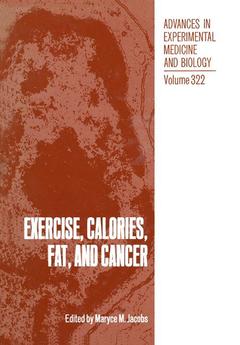1 Exercise, Calories, and Fat: Future Challenges.- I. Introduction.- II. Body Weight and Disease Risk.- III. Calories and Energy Expenditure.- IV. Food Composition Estimation and Evaluation.- V. Genetics, Diet, and Disease.- VI. Diets and Dietary Guidelines.- References.- 2 The Influence of Physical Activity on the Incidence of Site-Specific Cancers in College Alumni.- I. Introduction.- II. College Sports and Site-Specific Cancers.- III. Alumni Physical Activity and Site-Specific Cancers.- IV. Long-Term Physical Activity and Colon Cancer.- V. High Levels of Physical Activity and Prostate Cancer.- VI. Physical Activity and Breast Cancer Incidence.- VII. Conclusion.- References.- 3 Effects of Voluntary Exercise and/or Food Restriction on Pancreatic Tumorigenesis in Male Rats.- I. Introduction.- II. Materials and Methods.- III. Results.- IV. Discussion.- V. Summary.- References.- 4 Former Athletes Have a Lower Lifetime Occurrence of Breast Cancer and Cancers of the Reproductive System.- I. Introduction.- II. Subjects and Methods.- III. Results.- IV. Discussion.- References.- 5 Voluntary Exercise and Experimental Mammary Cancer.- I. Introduction.- II. The NMU Model.- III. The DMBA Model.- IV. The C3H/oµJ Mouse Mammary Tumor Model (MMTV).- V. The R13762 Metastasizing Mammary Tumor.- VI. Summary and Conclusions.- References.- 6 Effect of Amount and Type of Exercise on Experimentally Induced Breast Cancer.- I. Introduction.- II. General Comments on Methodology.- III. Presentation of Experimental Findings.- IV. Discussion.- V. Summary.- References.- 7 Modulation of Chemical Toxicity by Modification of Caloric Intake.- I. Introduction.- II. Animals and Diets.- III. Body Weight, Survival, and Pathology.- IV. Free Radical Detoxification.- V. Caloric Restriction and DrugMetabolism in the Liver.- VI. Chemical Carcinogenesis.- VII. Consequences for Human Nutrition.- VIII. Summary.- References.- 8 Calories, Fat, Fibers, and Cellular Proliferation in Swiss Webster Mice.- I. Introduction.- II. The Experimental Approach.- III. Dietary and Caloric Restriction.- IV. Fibers and Bulking Agents.- V. Fat.- VI. Overview.- VII. Summary.- References.- 9 Caloric Intake, Dietary Fat Level, and Experimental Carcinogenesis.- I. Introduction.- II. Fat Level, Energy Balance, and Cancer Incidence.- III. Discussion.- IV. Epilogue.- References.- 10 A Model System for Studying Nutritional Interventions on Colon Tumor Growth: Effects of Marine Oil.- I. Introduction.- II. Materials and Methods.- III. Results.- IV. Discussion.- V. Summary.- References.- 11 Enhancement of Pancreatic Carcinogenesis by Dehydroepiandrosterone.- I. Introduction.- II. Materials and Methods.- III. Results.- IV. Discussion.- References.- 12 Caloric Restriction and Experimental Carcinogenesis.- I. Introduction.- II. Caloric Restriction and Carcinogenesis.- III. Proposed Mechanisms for Inhibition of Tumorigenesis by Caloric Restriction.- References.- 13 Breast Cancer — The Optimal Diet.- I. Introduction.- II. The Evidence.- III. The Optimal Diet and Its Implementation in Clinical Practice.- IV. Summary.- References.- 14 Dietary Fat and Breast Cancer: Testing Interventions to Reduce Risks.- I. Introduction.- II. Possible Diet-Related Hypotheses.- III. Progress in Prospective Feasibility Studies to Date Testing the Fat Hypothesis.- IV. Unsettled Research Issues.- V. Future Directions.- References.- 15 Possible Mechanisms through which Dietary Lipids, Calorie Restriction, and Exercise Modulate Breast Cancer.- I. Introduction.- II. Dietary Lipids and Tumor Growth.- III. Energy Balance.- IV.Endocrine System.- V. Cytokines, Growth Factors, and Prostaglandins.- VI. Oncogenes.- VII. Modulation of Immune Function by Food Restriction and Physical Activity.- References.- 16 Dietary Fat, Calories, and Mammary Gland Tumorigenesis.- I. Introduction.- II. Amount of Dietary Fat and the Development of Mammary Tumors in Experimental Animals.- III. Type of Dietary Fat and the Development of Mammary Tumors in Experimental Animals.- IV. Dietary Fat and the Metastasis of Mammary Tumor Cells in Experimental Animals.- V. Dietary Fat and Calories in Mammary Tumor Development in Experimental Animals.- VI. Dietary Fat and the Growth of Human Breast Carcinomas Maintained in Immune-Deficient Mice.- VII. Summary.- References.- 17 Dietary Fat and Breast Cancer: A Search for Mechanisms.- I. Introduction.- II. Overview: Dietary Fat and Breast Cancer in Rodents.- III. Dietary Fat and Breast Cancer in Humans.- IV. Mechanisms of Action.- V. Conclusion.- References.- 18 Selected Recent Studies of Exercise, Energy Metabolism, Body Weight, and Blood Lipids Relevant to Interpretation and Design of Studies of Exercise and Cancer.- I. Introduction.- II. Factors that Influence Intake and Utilization of Calories.- III. Exercise and Blood Lipids.- IV. Endocrine Responses to Exercise.- V. Conclusion.- References.- Poster Abstracts.




